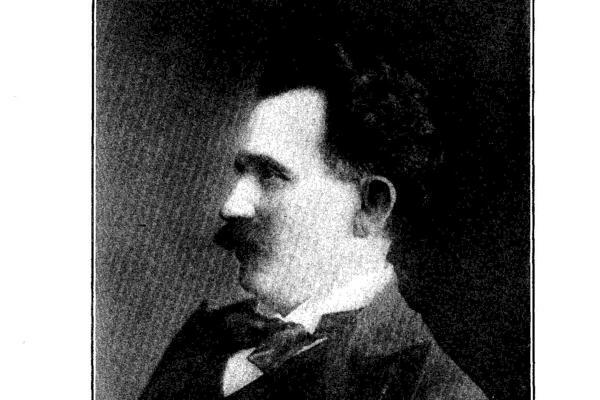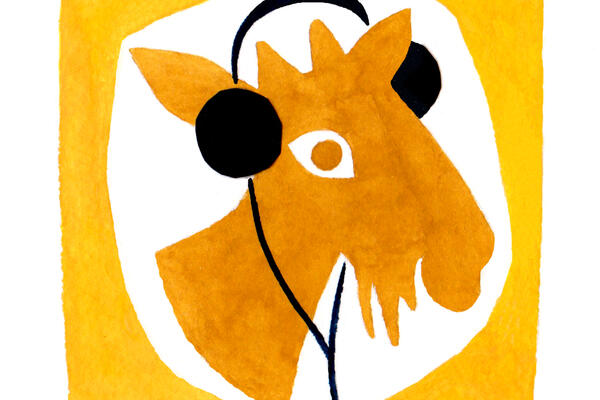
An Old Woman with Young Dreams
- Written by:
- Yente Serdatsky
- Translated by:
- Jessica Kirzane
- Published:
- Spring 2018
- Part of issue number:
- Translation 2018
“An Old Woman with Young Dreams” was published in the Forverts on November 11, 1920, and was never reprinted. Narrated by a flâneuse who observes the city and its people, like many of Serdatsky’s stories this one offers a picture of the day-to-day lives of immigrant women in New York, their unfulfilled longings and small pleasures.
A dignified mister, who’s more interested in my writing than in me as a person, says to me:
“Don’t you ever get weary of lowering yourself into the depths of human life to fish out the most interesting parts? It must be unpleasant to uncover and search the dark shadows of the human soul to find the bright sparks.
“You look upset, like you’re in a nightmare. Wake up! Now is the most beautiful time of year in New York. Take a stroll on the city streets, drink in everything up here on the surface, all that’s lighthearted and pleasant. See how light shimmers on the colorful dresses the rich ladies wear. See how golden rays glimmer on the blue rivers around New York, how they wrap around the tall buildings and stretch across the broad, wide, though crowded streets.”
You’re right, sir. I’ll take your advice. I’ll leave my heroines alone for a while and stop writing about them so much. They deserve a rest anyway. They may blunder through their dark corridors if I’m not here to help them find the way, but so be it. The street, in these bright days of autumn, is so dear to me. The colors are movingly rich. Nothing can get me down. I’ll go out, and I’ll see what’s out on the street!
The Flirt
I met her on the steps to the bridge that connects the Third Avenue Elevated to the Second Avenue line. I had no reason to hurry, so I was walking slowly. Other people hurried by: men, women, children, people of all ages and nationalities.
Everyone was in a hurry. I didn’t mind. Actually, I enjoyed the knowledge that my spot in the car was waiting for me. A train car is like a person’s heart. It always has room for everyone.
But one woman didn’t hurry past me. I heard her heavy breathing and plodding steps as she trudged behind me. We both paused at the landing before the next set of steps and looked at each other. She was a Jewish woman who looked to be about sixty. She was short and stocky, with a small neck and a wrinkled face. She had a blonde wig and was carrying several packages of satin socks. “Excuse me, miss, is this the right way to Grand Street downtown?”
I assured her that it was. I told her that I was going to the same street. She could go with me. I even offered to carry one of her packages.
She wouldn’t give me a single sock. We walked together for a few steps, and then she passed me. It was a long landing. I watched as she went, how she wobbled with heavy steps, and thought to myself, “Why is this old lady in such a hurry?”
A tall, sprightly man who looked to be about thirty-five passed me. I took him in. He had a dark face, with black eyes. I thought I saw an impatient look in them, as though he were saying, “Aren’t you embarrassed to be taking so long?” I marveled at his jaunty step. Suddenly he stopped still like he was caught on something, like something had stopped him in his tracks. He could go no farther. Right in front of him, like a wall, stood the old lady with her packages. She asked him something. He gestured toward a set of stairs. She asked again and then again. He bent over to her ear and explained, “Those steps over there! Ask the conductor, and he will tell you when you’re at Grand Street.”
He jumped onto another step that went in a different direction. I caught up to the old lady. I peeked at her face. It looked entirely different. Her eyes sparkled like those of a younger woman; her face blushed. Her pale lips smiled and she struggled to catch her breath.
We sat down across from each other. The two seats next to us were empty. We spoke to each other. I learned that her children are all grown. They live in the Bronx. They are all doing well. They make a good living, especially her adult grand-son. She’s carrying these packages of socks, vests, and trimming because she’s planning on making them into something new. If not, they would have thrown them away a long time ago.
Her “old man” died two years ago, but she’s still living. He was just a few years over seventy, but he had to go and catch cold. His sister, an old shrew, was a year older than him, and she’s still living. Her children have asked her to come stay with them, but she won’t go. She wants to end her life where he did. The walls, the dishes they bought together are dear to her. He was a good man; he was one of a kind.
We kept carrying on our conversation in front of two new passengers. A middle-aged woman with gray hair under her black hat was now sitting next to me. Her thin body was wrapped in a long, dark coat. Her face was delicate and pale. A very different passenger was sitting next to the old lady. He was a forty-year-old man, short, with broad shoulders and a red neck. His face was round like a plate, rosy, white, and handsome.
It was hard for him to squeeze his broad figure next to the stocky old lady with her packages that she wouldn’t put down. Once he sat, she turned to him, measured him with her damp eyes, moved her face close to his, and said, “Mister, excuse me, but what time is it?” She asked in broken English. He took out a large pocket watch, opened it, looked, and said, “Ten minutes to four.”
“What? What time? I can’t hear you!” She edged her head even closer to him. He put his lips by her ear. They looked like a couple of friends trying to find an excuse for cuddling in public. After the third time she told him she heard and thanked him, pressed herself against her packages, and looked out the window.
I watched her. Her face was on fire, her eyes sparkled, and a smile played about her dry lips. Her breath was hot and heavy.
The woman next to me also looked at the woman. A shadow of pity flickered over her delicate face. “That woman is so weak that it’s hard for her to breathe . . .” Weak people always pity the weak. But I thought of the legend of King Solomon, who understood the language of animals and birds. Ha ha! He was not suspicious of the animals, and birds did not hold back. No one holds back from me either.
But I understand the language of flirting and of desire. That language was comical when the old lady used it. I was full of good cheer when I disembarked on Grand Street.
The Litvak
It was lovely to walk on Grand Street on a sunny evening. Women stood by the store windows, and I stood with them. There’s plenty to look at and admire. In one window there was a colorful silk blouse stitched in gold, silver, and pearls, with short sleeves and a plunging neckline. How beautiful a woman would look in such a blouse! In another window there were silk sweaters with long fringes that looked like decorative church clothes. People stood in front of the window of the fur counter for a long time. So many animals! Minks, foxes, seals—a whole forest’s worth. They stood transfixed. The animals attracted even women who didn’t like wearing fur.
Another window displayed a fantastic tower hung with purses, works of art. They were embroidered with birds and flowers of pearl. In another window were clothes of all sorts of materials, with every kind of decoration. People stood at the window of the silk counter, admiring blue and rose negligees of thin silk with a fine sheen and broad sleeves that looked like birds. I thought it would be nice to have a few rooms on Riverside Drive and to sit by my writing desk wearing a negligee like that. Angels would float across my paper . . .
At the window of the dime store people were more impatient. They remembered the little things that they needed in their house, and then they remembered their homes and their landlords who wouldn’t give them anything except some walls. They thought of the leaky ceiling, of the rent money they would soon have to pay. They didn’t linger like they did by the other windows.
With these thoughts they turned to the next window, with its displays of silver plates and cut glass. The sun shines through the cut glass in streams of colored light. Blessed be the hands who work on such beautiful dishes that bring delight to the eye.
Fewer people walked on the other side of the street, and no one was standing by the windows during daytime. They are more serious businesses. A phonograph store, a piano store, a furniture store, picture houses, restaurants. Two women stood for a long time looking in the furniture store’s window. I also stood there, watching them. They were middle-aged women, well dressed, with faces that told of little joy and little worry. Peaceful faces of housewives who have everything they need in their homes.
“Do you see that big table, Bessie? If my sister and her family are going to stay with me, I’ll have to have that table.”
“So they’re really coming to you?”
“What do you think? I’d make them stay with strangers? We’ll get them situated. Just let them come in good health. I can’t wait to see her.”
“I’ll never see my sister again. Those hooligans murdered her.”
Their eyes grew teary as they remembered the land they’d left behind, where their relatives still suffer. The first woman philosophized, “You know, Bessie, it’s a strange world. Here we eat the best food, we wear wool and silk, and there? It’s a miracle to get even the humblest, oldest things. They’re almost afraid of something new. Did you see what joy they wrote in their letter? They kissed the pot, the sweaters, the socks . . . those old rags. Here we’d barely even look at such things.”
They both were silent as tears fell from their eyes. They forgot that they were standing on busy Grand Street, by the windows of a well-to-do furniture store, near a picture house where they sell tickets to the nightly showings. They hardly noticed the people looking at them. I also hardly noticed. The sadness enveloped all three of us as we remembered our home.
Bessie, who seemed to be a practical woman, was the first to gather herself. She wiped her face, laughed, and said, “Let’s go home, Esther. Soon it will be time for dinner.”
But Esther couldn’t calm herself so easily. She bowed her head. Her tears flowed as her chest heaved with sobs.
The other woman became impatient as she tried to console her friend. This is the first time I noticed she was a Litvak. She said samekhs instead of shins. “Shee here, don’t be shilly, Eshter. Don’t kill yourshelf over it. It’s Thurshday, and we need to buy food for Sabes. There’ll be plenty of fish, beef, and chicken. Your little Serke is probably already at home, and she musht be hungry!”
Serke must be an only daughter because when she heard the name, the crying woman shook herself off, wiped her face, and the two women hurried home.
I shed my sadness quickly too. The only thing that remained with me of the whole sad story was the memory of the woman’s funny consonants. I felt happy again, though I was a bit ashamed to admit it. Above the sign for the picture house was written in big letters: “CHARLIE CHAPLIN.” I bought a ticket and went inside to have a little fun. But I’ll tell you about that another time.
YENTE SERDATSKY (née Raybman, 1877–1962) was born in Aleksotas, near Kovno (Kaunas) in what is now Lithuania. Her childhood home was a gathering place for Yiddish writers, and she was acquainted from a young age with Yiddish literature. She married, had three children, ran a grocery store, and in 1905 left her family to pursue her writing in Warsaw, where she received encouragement from I. L. Peretz. In 1906 she and her family emigrated to the United States, eventually settling in New York City, where she ran a soup kitchen. She published short sto-ries, sketches, and one-act plays in many Yiddish periodicals and was a regular contributor and eventually a contributing editor at the Forverts. In 1922 she left the Forverts and the literary scene, not publishing again until 1949–1955, when she contributed dozens of stories to the Nyu Yorker Vokhnblat. Her only book publication was her collected early writings, published in 1913.
JESSICA KIRZANE is an incoming lecturer in Yiddish at the University of Chicago. She holds a PhD in Yiddish studies from Columbia University. Kirzane is the managing/pedagogy editor of In geveb: A Journal of Yiddish Studies and was a 2017 translation fellow at the Yiddish Book Center. Her previous translations can be found in jewishfiction.net, Pakn Treger, and Have I Got a Story for You (W. W. Norton, 2016).



